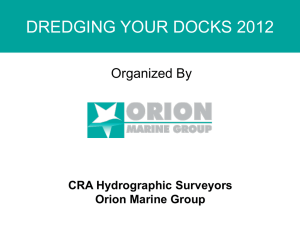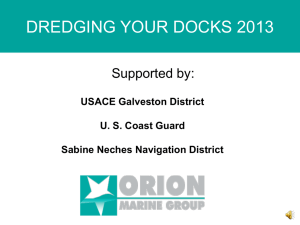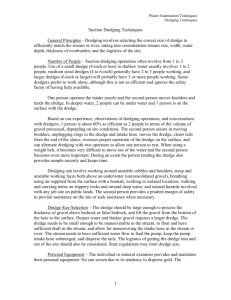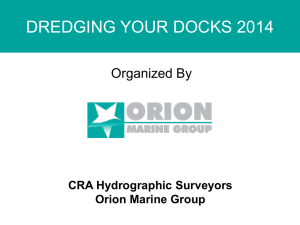Eldorado Dredge Visitor Guide
advertisement
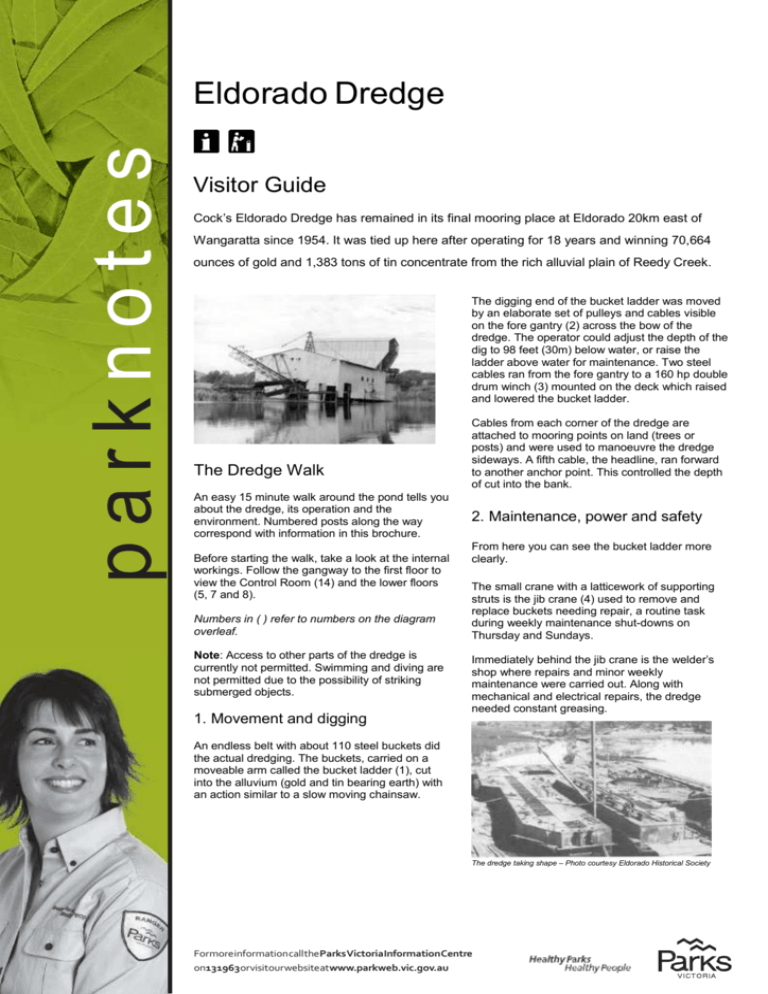
parknotes Eldorado Dredge Visitor Guide Cock’s Eldorado Dredge has remained in its final mooring place at Eldorado 20km east of Wangaratta since 1954. It was tied up here after operating for 18 years and winning 70,664 ounces of gold and 1,383 tons of tin concentrate from the rich alluvial plain of Reedy Creek. The digging end of the bucket ladder was moved by an elaborate set of pulleys and cables visible on the fore gantry (2) across the bow of the dredge. The operator could adjust the depth of the dig to 98 feet (30m) below water, or raise the ladder above water for maintenance. Two steel cables ran from the fore gantry to a 160 hp double drum winch (3) mounted on the deck which raised and lowered the bucket ladder. The Dredge Walk An easy 15 minute walk around the pond tells you about the dredge, its operation and the environment. Numbered posts along the way correspond with information in this brochure. Before starting the walk, take a look at the internal workings. Follow the gangway to the first floor to view the Control Room (14) and the lower floors (5, 7 and 8). Numbers in ( ) refer to numbers on the diagram overleaf. Note: Access to other parts of the dredge is currently not permitted. Swimming and diving are not permitted due to the possibility of striking submerged objects. 1. Movement and digging Cables from each corner of the dredge are attached to mooring points on land (trees or posts) and were used to manoeuvre the dredge sideways. A fifth cable, the headline, ran forward to another anchor point. This controlled the depth of cut into the bank. 2. Maintenance, power and safety From here you can see the bucket ladder more clearly. The small crane with a latticework of supporting struts is the jib crane (4) used to remove and replace buckets needing repair, a routine task during weekly maintenance shut-downs on Thursday and Sundays. Immediately behind the jib crane is the welder’s shop where repairs and minor weekly maintenance were carried out. Along with mechanical and electrical repairs, the dredge needed constant greasing. An endless belt with about 110 steel buckets did the actual dredging. The buckets, carried on a moveable arm called the bucket ladder (1), cut into the alluvium (gold and tin bearing earth) with an action similar to a slow moving chainsaw. The dredge taking shape – Photo courtesy Eldorado Historical Society Formoreinformation call theParks VictoriaInformationCentre on131963orvisitourwebsiteatwww.parkweb.vic.gov.au Further along to your right, protruding from the corrugated iron sheeting, are brackets which held the 6,600 volt electricity cable that ran across the pond on floats (44 gallon drums) and in through the opening where the low and high portions of the roof meet. The cable terminated in a transformer to 440 volt 3 phase power to drive the main motors and 110 volt single phase power for lights and smaller motors. Despite hazardous working conditions, no fatal or serious injury ever occurred on the dredge. The only fatality was that of Ted Fealy who drowned when a steep bank at the edge of the dredge pond collapsed on his boat during maintenance 4. Removing waste F w The dredge’s onboard treatment plant consisted of a large rotary screen or sieve (6), and various jigs (agitators) (7). The plant separated out the small proportion of gold and tin in the alluvium and discarded the bulk of the material which was ejected from chutes or a pipe at the stern. P c p T Course gravel and stones were caught in the rotary screen, s passed into the lower semi-circular “stone-chute” (8) and s discharged from the stern, fairly close to the dredge. F lo a work on the bucket ladder. 3. Spare buckets L v w Originally the buckets were made of cast chrome steel with digging lips of manganese steel riveted on for additional toughness and wear resistance. They can hold around 12 3 cubic feet (0.36m ) and weigh 1.6 tons. 5 Lips on the buckets required regular repair, largely through striking bedrock where it rose close to the surface on the northern boundary of the claim. C o a a s w Bucket band failures in 1939 resulted in months of delay. The failure stemmed from the installation of a more powerful 320 hp motor. The original motor was 200 hp (5). The new motor placed extra stress on the bucket band. Stronger was not necessarily better! The number 8 welded on the bucket replaces the original caston CE (Commonwealth Engineering) 8, which you can see below and to the left and nearly worn away on some of the buckets. The lip on this bucket has been extensively repaired. Early visitors to the construction site 1936 – Photo courtesy F Richardson T C h p c Finer gravel and sand which passed through the perforated walls of the rotary screen was discarded in one of two ways. Poor grade material was simply ejected via the upper semicircular chute (9). Gold and tin bearing alluvium went through primary and secondary jigs to separate the metals. The waste material from the primary jigs was discharged as a slurry into open troughs or “launders” (10) running down each side of the dredge and protruding from the stern. The wall near you was built in about 1949 to form a settling pond or ‘slum’ dam. Some of the larger settling ponds (former sluicing holes) can still be seen along the Eldorado/Woolshed Road. Silt or “slum” dams gradually became ‘choked’ and were often abandoned. A glimpse across the slum dam indicated the poor rate of regeneration in these areas – weeds and wattles predominate. Fine waste from the secondary jigs was pumped through the long pipe suspended from the stern on a lattice frame (11), and discharged on top of the course gravel and stones. Layering of fine waste on top of course was supposed to help vegetation regrowth after dredging finished. You can see whether this happened or not. 5. Reedy Creek Clean, reliable and plentiful water was essential for dredging operations, firstly to enable the dredge to float and move around and secondly for treatment and transport of the alluvium from the buckets into the rotary screen. Other jets sprayed the material in the rotary screen and jigs. Most of the water was supplied from upstream. To ensure a supply of clean water and to protect Reedy Creek, large settling ponds (slum dams) were constructed to hold muddy water. Once the silt had settled, clean water was pumped back into the dredge pool. In 1936 the settling ponds covered 62 acres and there were three pumping plants. In 1951, Reedy Creek was diverted to its present position so that dredging could occur in the original creek bed. The dredge, which was further upstream, then followed the original course downstream, working over previously undredged ground. Near the stern of the dredge you will notice a small tin shed perched precariously on railings over the dredge pond. This “dunny” (12) was one of the very few staff amenities on board. . For further information Parks Victoria Information Centre Call 13 1963 or visit the Parks Victoria website www.parkweb.vic.gov.au Visitor Information Centre Corner Tone Road and Handley Street Wangaratta 3677 Freecall: 1800801 065 Caring for the environment 6. Cranes and meters From this point you can look up and see the overhead travelling crane. The beam (13) extending out over the water was used to lift heavy equipment on and off the dredge. Further toward the bow at first floor level is the Control Room (14). An elaborate system of electrical switches and meters (15) controlled the various motors and other equipment. In the latter stages of the dredge’s life, the office and workshop were moved to this vicinity. Soon after the dredge ceased operation, the “Tin shed” and workshop buildings and plant were sold and presumably removed. Only a few pieces of equipment remain, including an amalgamating barrel, various motors, capacitor banks, winch drum etc. The former office was used as a caretaker’s residence for about 20 years after 1954. The site of this building was further up the hill in amongst the trees. Once the caretaker left, the building became derelict and was demolished. A few bricks mark its former location. Help us look after your park by following these guidelines: Please take rubbish home with you for recycling or disposal All native plants, animals, historical and archaeological sites and geographic features are protected by law Dogs are not permitted in the park Firearms are prohibited Light fires only in fire places provided. No fires, including barbecues, may be lit on a day of Total Fire Ban Warby Range State Park is in the North East Fire Ban District Bring your own firewood for barbecues. Gas barbecues are recommended Prospecting is permitted in designated areas. Prospectors must hold a current Miner's Right. Refer to the Prospecting Guide for more information. Vehicles, including motor bikes, may only be used on formed open roads. Drivers must be licensed and vehicles registered and roadworthy The control room c 1936 – Photo courtesy Eldorado Historical Society Mechanical levers were used to start or stop the winch (16) motors. These winches in turn controlled all movement of the dredge including the bucket ladder and band. Costs in treating gold and tin alluvium increased dramatically in the early 1950s, forcing suspension of dredging on 13 August 1954. The dredge was docked at its present site on 24 August 1954 and has not moved since. 7. On shore The jigs on the dredge produced a black sand containing gold, tin and other minerals. This was taken ashore by rowboat, and then to a treatment plant known as the “Tin shed” (about 1km from the dredge site). Gold was separated from tin and other substances using an amalgamating barrel, then retorted and smelted into gold ingots. The tin ore was further processed and bagged. In addition to the “Tin shed” there was an office in Eldorado and a maintenance workshop where buckets and pumps were repaired and other maintenance jobs carried out. The caretaker’s home for 20 years – photo courtesy F Richardson Future of the dredge Despite attempts by the company to sell the dredge it finally passed into government hands in 1984. Rusting of the pontoons caused the dredge to take water and list. The future for the largest and most intact bucket gold dredge in Australia was in doubt. Cock’s Eldorado dredge is now listed on the Victorian Heritage Register and Parks Victoria is investigating various strategies for its improved long term conservation. This may include refloating the dredge. A cathodic protection system, funded by a grant from Heritage Victoria, has been installed to stop rusting. How to get there Eldorado Dredge is located 17km east of Wangaratta on the Wangaratta-Eldorado Road. June 2007 Printed on Australian-made, 100% recycled paper.
